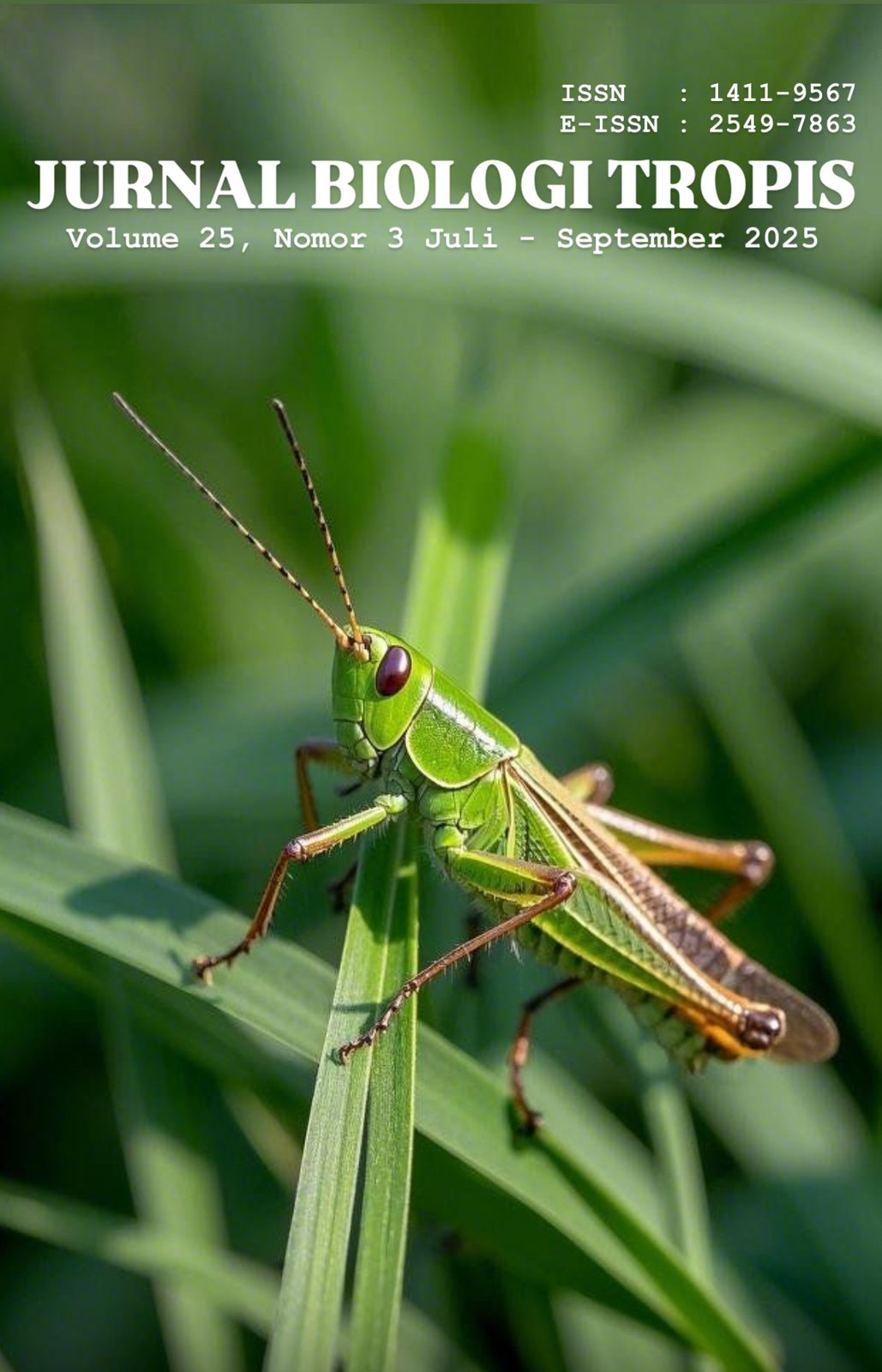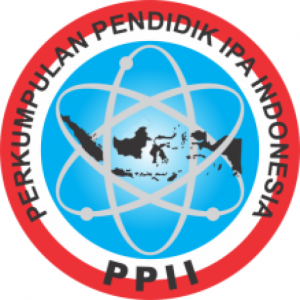Characteristics of the Antagonistic Fungus Nigrospora Oryzae Against the Fungus Fusarium as a Source of Biological Learning in Chili Plants
Authors
Moh. Ilham Yusuf , Iin MurtiniDOI:
10.29303/jbt.v25i3.9463Published:
2025-07-15Issue:
Vol. 25 No. 3 (2025): Juli-SeptemberKeywords:
F. oxysporum, F. solani, Fusarium Wilt, Learning resources N. oryzae.Articles
Downloads
How to Cite
Downloads
Metrics
Abstract
One of the primary diseases that attack chilli plants (Capsicum annum) is Fusarium wilt, which is caused by the pathogenic fungi F. oxysporum and F. solani. This study aims to analyze the parasitism mechanism of the antagonistic fungus N. oryzae against the pathogen that causes Fusarium wilt in chilli. The method used was a dual culture technique antagonism power test with observations carried out every day from day 0 to day 5. The results of the study showed that the inhibition rate achieved was 33.3% against F. oxysporum and 18.18% against F. solani with the antagonism mechanism of N.oryzae, including 1) Mycoparasitism; 2) Degradation of pathogen cell wall; 3) competition for nutrients and space. The results showed that N. oryzae could inhibit the growth of F. solani and F. oxysporum. This proves that N. oryzae has the potential to be an effective antagonistic fungus in controlling both pathogens. The contribution of the results of the introduction of fungal antagonism is used as a learning resource to understand the concept of learning fungi through direct practical activities in the Laboratory.
References
Agustina, N., Purnawati, A., & Prasetyawati, E. T. (2022). Potensi konsorsium bacillus spp. dan pseudomonas fluorescens untuk mengendalikan penyakit layu fusarium pada tanaman cabai rawit. Plumula : Berkala Ilmiah Agroteknologi, 10(1), 1–8. https://doi.org/10.33005/plumula.v10i1.64
Al-Mutar, D. M. K., Alzawar, N. S. A., Noman, M., Li, D., & Song, F. (2023). Suppression of Fusarium Wilt in Watermelon by Bacillus amyloliquefaciens DHA55 through Extracellular Production of Antifungal Lipopeptides. Journal of Fungi, 9(3). https://doi.org/10.3390/jof9030336
Al-Mutar, D. M. K., Noman, M., Alzawar, N. S. A., Qasim, H. H., Li, D., & Song, F. (2023). The Extracellular Lipopeptides and Volatile Organic Compounds of Bacillus subtilis DHA41 Display Broad-Spectrum Antifungal Activity against Soil-Borne Phytopathogenic Fungi. Journal of Fungi, 9(8). https://doi.org/10.3390/jof9080797
Aliah, Fitria, Sari, M., & Zubaidah. (2024). PENTINGNYA SUMBER BELAJAR DALAM PENDIDIKAN DI SEKOLAH. Jurnal Pendidikan KITA, 1, 42–50.
Anggoroputro, C., & Salamah, Z. (2021). Analisis Potensi Hasil Penelitian Famili Palmae di Sepanjang Pantai Parangtritis Sampai Depok sebagai Sumber Belajar Biologi. Jurnal Pendidikan Biologi Undiksha, 8(3), 170–179.
Ashwini, S., & Rajagopal, K. (2016). Bioactivity of the extract from an endophytic fungi Nigrospora Oryzaisolated from Pterolobium Hexapetalum-(Roth.). International Journal of Pharma and Bio Sciences, 7(4), B167–B170.
Badan Pusat Statistik Provinsi Jawa Timur. (2022). Produksi Tanaman Sayuran Cabai Besar, Cabai Rawit, Cabai Keriting Menurut Kabupaten/Kota dan Jenis Tanaman di Provinsi Jawa Timur. Jatim BPS.
Beka, B., & Pichiah, G. (2021). Response of hot pepper (Capsicum annuum L.) to major fungal diseases under field and greenhouse conditions in Horo Guduru Wollega, Oromia, Ethiopia. African Journal of Agricultural Research, 17(6), 923–932. https://doi.org/10.5897/ajar2020.14967
Dutta, S., Houdinet, G., NandaKafle, G., Kafle, A., Hawkes, C. V, & Garcia, K. (2023). Agrobacterium tumefaciens-mediated transformation of Nigrospora sp. isolated from switchgrass leaves and antagonistic toward plant pathogens. Journal of Microbiological Methods, 215. https://doi.org/10.1016/j.mimet.2023.106849
Gabrekiristos, E., & Demiyo, T. (2020). Hot Pepper Fusarium Wilt (Fusarium oxysporum f. sp. capsici): Epidemics, Characteristic Features and Management Options. Journal of Agricultural Science, 12(10), 347. https://doi.org/10.5539/jas.v12n10p347
Ghanem, A., Al-Karmalawy, A. A., Morsy, N. E., Elsabahy, M., & Rayan, A. M. (2025). Antimicrobial and Cytotoxic Activities of Nigrospora oryzae Endophytic Fungus Isolated from Moringa oleifera. Egyptian Journal of Medical Microbiology (Egypt), 34(1), 227–236. https://doi.org/10.21608/ejmm.2024.334620.1368
Girma, A. (2022). In Vitro Biocontrol Evaluation of Some Selected Trichoderma Strains against the Root Pathogen Fusarium oxysporum of Hot Pepper (Capsicum annum L.) in Bure Woreda, Ethiopia. International Journal of Microbiology, 2022. https://doi.org/10.1155/2022/1664116
Halimah, M., Sanjaya, Y., & Kristi, M. (2024). Effect of Trichoderma Isolate from various regions on the growth inhibition of Fusarium sp on red chili ( Capsicum annuum ). 17(1), 25–29. https://doi.org/10.57182/jbiopestic.17.1.25-29
Hong, S., Jv, H., Lu, M., Wang, B., Zhao, Y., & Ruan, Y. (2020). Significant decline in banana Fusarium wilt disease is associated with soil microbiome reconstruction under chilli pepper-banana rotation. European Journal of Soil Biology, 97(August 2019), 103154. https://doi.org/10.1016/j.ejsobi.2020.103154
Ihkwanisa, N., Nugraheni, I. A., Kurniawati, T., & Fardhani, D. M. (2023). Uji antagonis Trichoderma spp terhadap layu Fusarium tanaman cabai (Capsicum annum). Prosiding Seminar Nasional Penelitian Dan Pengabdian Kepada Masyarakat LPPM Universitas ’Aisyiyah Yogyakarta, 1, 244–252.
Irwandi, I., & Fajeriadi, H. (2020). Pemanfaatan Lingkungan sebagai Sumber Belajar untuk Meningkatkan Minat dan Hasil Belajar Siswa SMA di Kawasan Pesisir, Kalimantan Selatan. BIO-INOVED : Jurnal Biologi-Inovasi Pendidikan, 1(2), 66. https://doi.org/10.20527/binov.v1i2.7859
Jamil, A., Musheer, N., & Ashraf, S. (2021). Antagonistic potential of Trichoderma harzianum and Azadirachta indica against Fusarium oxysporum f. sp. capsici for the management of chilli wilt. Journal of Plant Diseases and Protection, 128(1), 161–172. https://doi.org/10.1007/s41348-020-00383-1
Muhammad, N., Rajput, N. A., Atiq, M., Sahi, S. T., Rehman, A., Hameed, A., Kachelo, G. A., & Ahmed, S. (2022). Integrated Management of Fusarium Wilt of Chilli Caused By Fusarium Oxysporum F. Sp. Capsici Through Different Management Approaches. Pakistan Journal of Botany, 54(5), 1963–1970. https://doi.org/10.30848/PJB2022-5(13)
Mustofa, A., & Hastuti, U. S. (2024). Antagonism and mycoparasitism mechanism of T. harzianum against pathogenic fungus species of F. oxysporum and Capnodium sp. Inornatus: Biology Education Journal, 4(1), 1–10. https://doi.org/10.30862/inornatus.v4i1.581
Mustofa, A., Hastuti, U. S., & Susanto, H. (2025). Endophytic fungi isolated from Heliotropium indicum and their antagonism activity toward Fusarium solani and F. oxysporum. Biodiversitas, 26(2), 617–627. https://doi.org/10.13057/biodiv/d260209
Pasalo, N. M., Kandou, F. E. F., & Singkoh, M. F. O. (2022). Uji Antagonisme Jamur Trichoderma sp. Terhadap Patogen Fusarium sp. pada Tanaman Bawang Merah Allium cepa Isolat Lokal Tonsewer Secara In vitro. Jurnal Ilmu Alam Dan Lingkungan, 13(2), 1–7.
Pramana, A. (2024). STUDI LITERATURE : PERAN SERTIFIKASI DALAM MENINGKATKAN PROFESIONALITAS GURU LITERATURE STUDY : THE ROLE OF CERTIFICATION IN IMPROVING TEACHER PROFESSIONALITY. Jurnal Intelek Dan Cendikiawan Nusantara, 1, 5845–5855.
Reddy, N. H. S., Rajamohan, K., Lakshmidevi, P., & Vigneshwaran, K. (2024). Regional survey , isolation , and morphotypes diversity of Fusarium Wilt pathogen in chilli from Andhra Pradesh and Tamil Nadu. September. https://doi.org/10.33545/26174693.2024.v8.i9Sq.2359
Ruswandari, V. R., Syauqi, A., & Rahayu, T. (2020). Uji Antagonis Jamur Trichoderma viride dalam Menghambat Pertumbuhan Jamur Patogen Alternaria porri Penyebab Penyakit Bercak Ungu pada Tanaman Bawang Merah (Allium ascalonicum L.). Biosaintropis (Bioscience-Tropic), 5(2), 84–90. https://doi.org/10.33474/e-jbst.v5i2.255
Salahuddin, S. (2022). Penggunaan Sumber Belajar Beragam untuk Meningkatkan Prestasi Belajar Siswa Mata Pelajaran Ekonomi pada Materi Pelaku Ekonomi dalam Kegiatan Ekonomi di Kelas X-1 Semester I SMAN 2 Bolo Tahun Pelajaran 2021/2022. Jurnal Pendidikan Dan Pembelajaran Indonesia (JPPI), 2(1), 67–80. https://doi.org/10.53299/jppi.v2i1.170
Samsinar, S. (2019). Urgensi Learning Resources ( Sumber Belajar ). Jurnal Kependidikan, 13, 194–205.
Sanothan, A., Montong, V. B., & Lengkong, M. (2023). Antagonistic Test of Trichoderma sp. against Anthracnose Disease, Colletotrichum sp. on Curly Chili Capsicum annuum L. in the Laboratory. Jurnal Entomologi Dan Fitopatologi, 3(1), 15–23.
Sempere, F., & Santamarina, M. P. (2008). Biological control of one species belonging to the dominant mycobiota of rice of Valencia. Annals of Microbiology, 58(1), 7–14. https://doi.org/10.1007/BF03179438
Sha, H., Liu, X., Xiao, X., Zhang, H., Gu, X., Chen, W., & Mao, B. (2023). Nigrospora oryzae Causing Leaf Spot Disease on Chrysanthemum × morifolium Ramat and Screening of Its Potential Antagonistic Bacteria. Microorganisms, 11(9). https://doi.org/10.3390/microorganisms11092224
Susanna, S., Alfizar, A., & Fitriadi, E. (2023). Efektivitas Dosis dan Waktu Aplikasi Pupuk Kompos Trico-Glio untuk Pengendalian Penyakit Layu Fusarium (Fusarium sp.) pada Tanaman Cabai Merah (Capsicum annum L.). Agrikultura, 34(3), 435. https://doi.org/10.24198/agrikultura.v34i3.42422
Tao, Y., Yang, C., Yu, S., Fu, F., & Dai, T. (2024). New Occurrence of Nigrospora oryzae Causing Leaf Blight in Ginkgo biloba in China and Biocontrol Screening of Endophytic Bacteria. Microorganisms, 12(11). https://doi.org/10.3390/microorganisms12112125
Thanabalasingam, D., Kumar, N. S., Jayasinghe, L., & Fujimoto, Y. (2015). Endophytic fungus nigrospora oryzae from a medicinal plant coccinia grandis, a high yielding new source of phenazine-1-carboxamide. Natural Product Communications, 10(10), 1659–1660.
Ting, A. S. Y., Mah, S. W., & Tee, C. S. (2010). Identification of volatile metabolites from fungal endophytes with biocontrol potential towards fusarium oxysporum F. sp. cubense race 4. American Journal of Agricultural and Biological Science, 5(2), 177–182. https://doi.org/10.3844/ajabssp.2010.177.182
Ulya, H., Darmanti, S., & Ferniah, R. S. (2020). Pertumbuhan Daun Tanaman Cabai (Capsicum annuum L.) yang Diinfeksi Fusarium oxysporum pada Umur Tanaman yang Berbeda. Jurnal Akademika Biologi, 9(1), 1–6.
Wati, V. R., Yafizham, & Fuskhah, E. (2020). Pengaruh solarisasi tanah dan pemberian dosis Trichoderma harzianum dalam pengendalian penyakit layu fusarium pada cabai (Capsicum annum L.). J. Agro Complex, 4(1), 40–49.
Winn, R. M., Gil-Lamaignere, C., Maloukou, A., Roilides, E., Maglaveras, N., Gaustad, P., Abrahamsen, T. G., Denning, D. W., Meis, J. F. G. M., Verweij, P. E., Rodriguez-Tudela, J.-L., & Petrikkos, G. (2003). Interactions of human phagocytes with moulds Fusarium spp. and Verticillium nigrescens possessing different pathogenicity. Medical Mycology, 41(6), 503–509. https://doi.org/10.1080/1369378030001615394
Yang, P. (2014). Pathogenic fungi induce the expression of trichoderma asperellum cell wall degrading enzymes in the process of mycoparasitism. Advanced Materials Research, 937, 282–285. https://doi.org/10.4028/www.scientific.net/AMR.937.282
Yang, S., Su, S., Cen, R.-H., Sun, L.-J., Yang, X.-Q., Yang, Y.-B., & Ding, Z.-T. (2022). A New Butenolide from the Co-Culture of the Endophyte Irpex lacteus, the Phytopathogenic Nigrospora oryzae, and the Host Dendrobium officinale. Chemistry of Natural Compounds, 58(3), 404–406. https://doi.org/10.1007/s10600-022-03693-y
License
Copyright (c) 2025 Moh. Ilham Yusuf, Iin Murtini

This work is licensed under a Creative Commons Attribution 4.0 International License.

Jurnal Biologi Tropis is licensed under a Creative Commons Attribution 4.0 International License.
The copyright of the received article shall be assigned to the author as the owner of the paper. The intended copyright includes the right to publish the article in various forms (including reprints). The journal maintains the publishing rights to the published articles.
Authors are permitted to disseminate published articles by sharing the link/DOI of the article at the journal. Authors are allowed to use their articles for any legal purposes deemed necessary without written permission from the journal with an acknowledgment of initial publication to this journal.


























